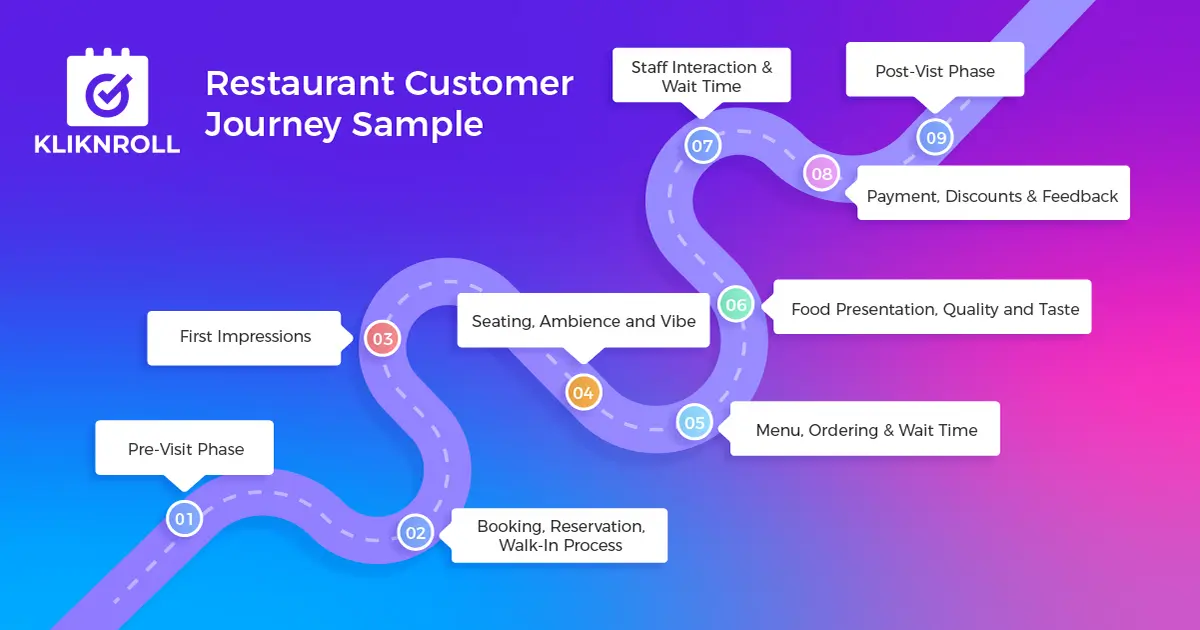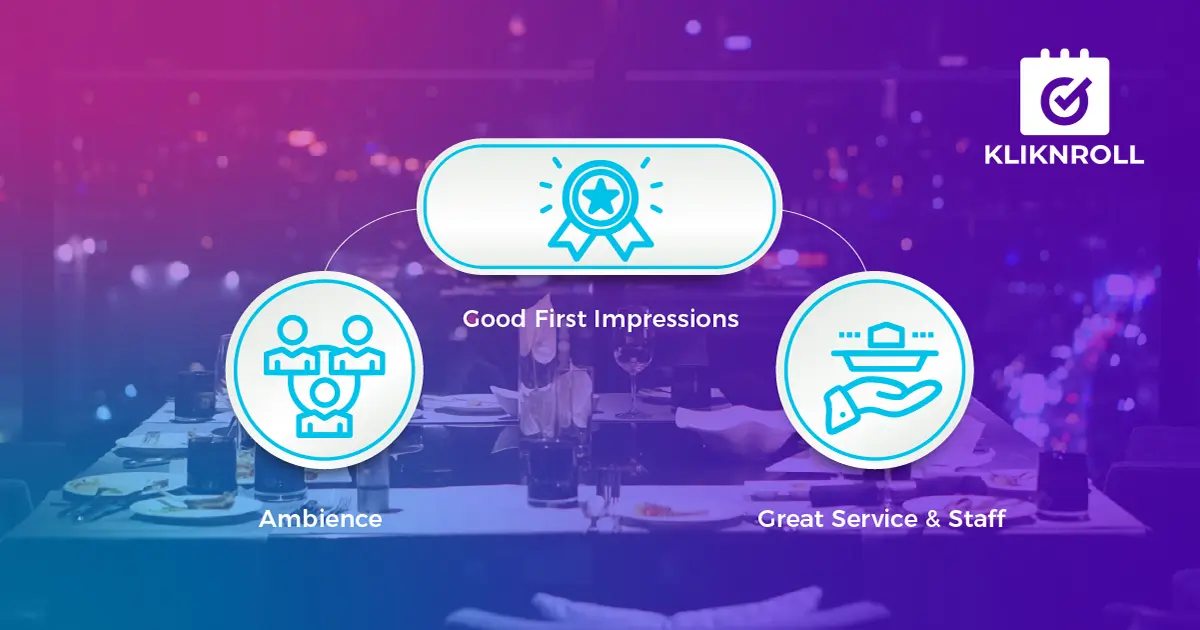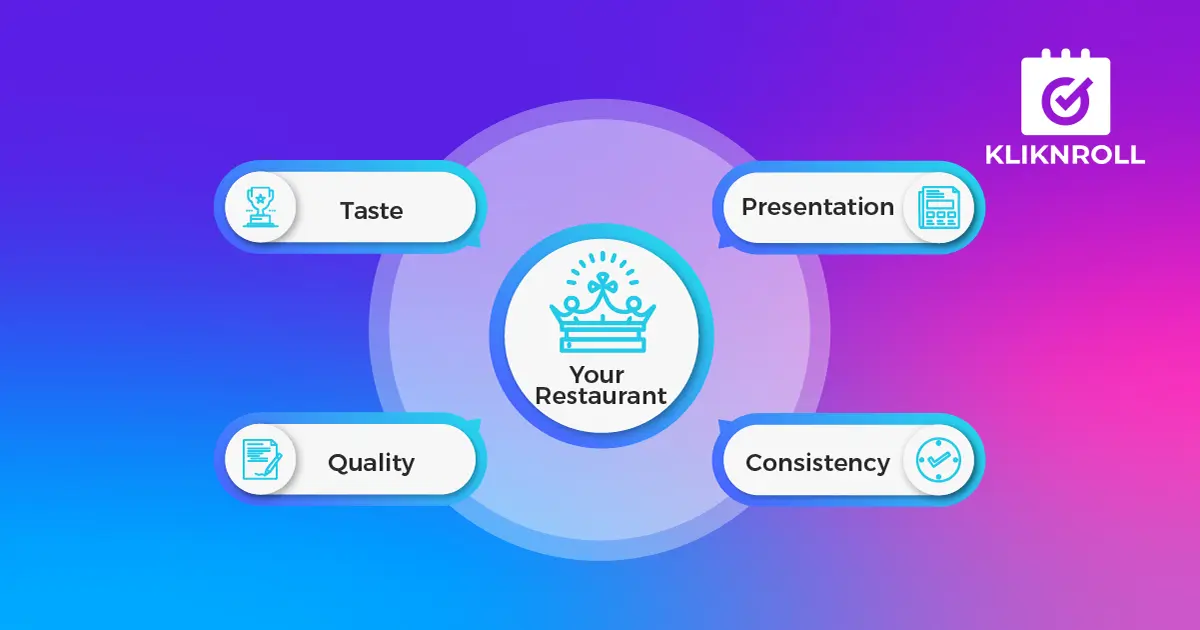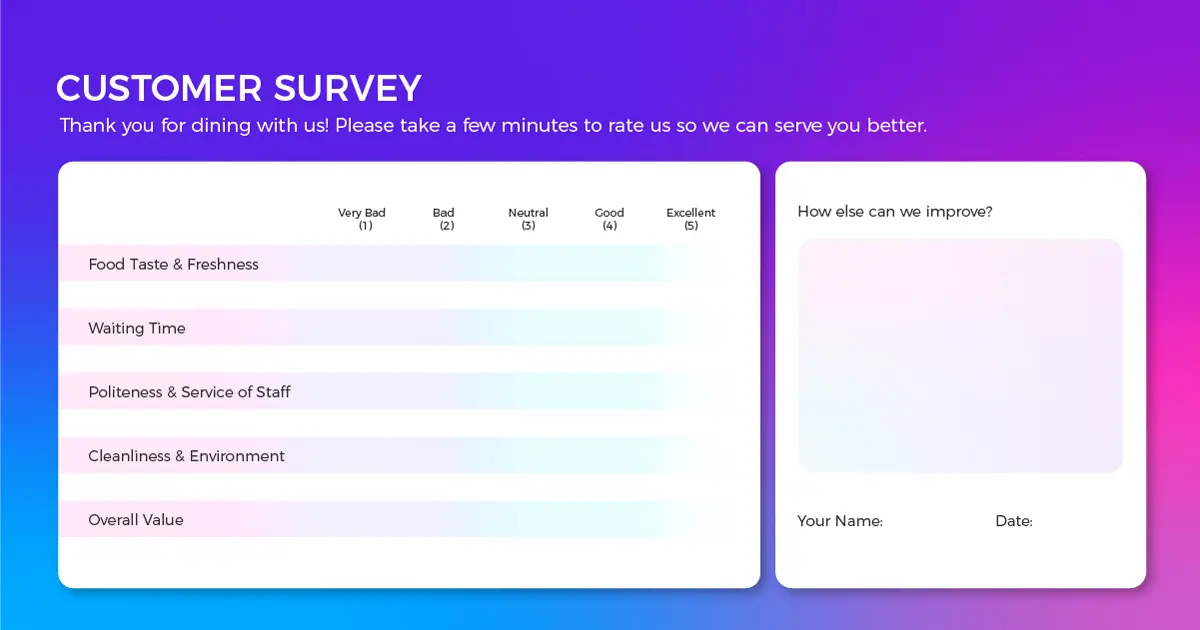Table of Contents
You might’ve heard the phrase restaurant customer journey thrown around once in a while in the industry. But what is it? How can you quantify and use a customer journey to your advantage as a restaurant owner?
What do you need to do? How can you take this data to improve loyalty and bring in more customers? That’s what we’re here to find out! Stay tuned, as you might learn a thing or two!
While we’re focusing on restaurants, this approach also applies broadly to the food and beverage customer journey. Even if you run a café, this same customer journey map cafe framework applies with a few small tweaks.
What Exactly is the Customer Journey in a Restaurant?

To put it simply, the restaurant customer journey involves every step a restaurant customer takes, from their initial discovery or interest in your restaurant to the moment they leave, and even beyond that.
The customer journey includes the guest experience on your website, the customer’s actual in-dining experience, and any following interaction.
It is a crucial component of customer service in your restaurant.
Acknowledging the customer journey means understanding that customers’ expectations and experiences don’t start and end at the table. It extends from each customer touchpoint to the next.
The journey encapsulates the customer experience which is everything from the atmosphere, menu, and service quality.
Offering an exceptional customer experience ensures that each restaurant customer feels valued, thereby enhancing your restaurant’s reputation and profits.
Thus, understanding the restaurant customer journey is a surefire way to elevate customer service and your brand. This serves as a customer journey map restaurant example that can be adapted to your unique service model.
A Practical Restaurant Customer Journey Map
Creating a practical restaurant customer journey map is essential in understanding and improving customer experience.
When building a customer journey map for your restaurant, remember it’s not just about the destination, but the journey itself. Every dining experience in your restaurant initiates a new journey map.
1. Restaurant Pre-Visit Phase - Website & Online Presence
The pre-visit phase is arguably one of the most important parts of the customer journey.
Potential guests turn to a restaurant’s website and/or third-party reviews for their first taste of what’s to come.
Having a website is a great way to attract more visitors that come through your door. Not only can it potential customers valuable information like your menu, location, opening hours, and other promotions, but it can also help with SEO (Search Engine Optimization).
To those of you who might not understand what it means, SEO is essentially an optimization strategy that gives you the best chance of ranking higher and showing up more than your competitors when customers look for restaurants to dine in at, on Google.
Reviews tie into this as well, as the more positive reviews you have, the more likely you are to show up.
A great tip to know is that it’s important to respond to every review, negative or positive. This tells potential customers and Google that you are active and care about their customer experience.
This is a win-win situation, as customers will be more likely to visit and Google will also favor you more in the long run! Remember, customers can’t experience your restaurant if they cannot find you in the first place!
2. Booking, Reservation, or Walk-In Process
The second phase in a restaurant customer journey involves booking, reservation, or deciding to walk into a restaurant.
A reservation implies that they’re either a returning customer, recommended you via word-of-mouth, or found your restaurant online.
Whereas a walk-in customer could be a combination of everything mentioned above or could be making a spontaneous decision to dine in.
No matter the method, the goal is to ensure the customer’s journey starts on a positive note.
You don’t want your booking or reservation process to be a mess or not having a member of staff greet a walk-in customer at a restaurant.
Problems like these don’t leave a good impression and can dissuade potential customers from ever coming to your restaurant.
No matter how good your food is, it won’t do very much if customers aren’t coming in because of this bottleneck.
To solve this problem, KlikNRoll builds a streamlined and customizable solution that allows your potential customers to reserve a table with a few taps of their smartphone screen!
The best part is that you get to keep your restaurant’s branding elements like color and whatever elements you want to include!
One of our prominent clients, the Murray Hotel in Hong Kong, managed to generate almost $400,000 in revenue through our online booking system for their restaurant! This came in incredibly helpful when they held special events, and we know that we can help you out too!
Contact us and we’ll even give you some ideas on how to start – no strings attached!
3. Restaurant First Impressions

When we talk about a restaurant customer’s journey, one pivotal stage is the ‘first impression.’
Your restaurant’s very first approach matters tremendously in shaping the entire dining experience.
Those initial moments, whether it’s the warm greeting at the door or the engaging ambiance, can set the tone for the rest of their dining experience.
On top of all that, staff training is by far the most important for this because they’re the first point of contact for the customers.
It might sound obvious, but make sure your staff is attentive and polite. How guests are treated at the door sets the tone for the rest of the customer journey.
It’s not just the staff at the front, but bussers and servers play an important role too. One of our editors went to an Italian restaurant the other day and despite a warm greeting, was put off because there were uncleared tables all around them that left them with a sour taste.
Also, having an outdoor menu sign is an old-school way that help improve first impressions, especially for potential walk-in customers. That’s why you can see so many outdoor menu signs while you’re out and about – because it’s an effective way to lure potential customers in.
Images, and food descriptions incorporated with your branding can help your restaurant stand out while improving ordering and table turnover (because they already know what they want to order).
Making sure that your restaurant nails the first impression is something that cannot be overlooked in the customer journey map.
Remember, the key is to make each process as pleasant as possible for your customers.
4. Seating, Ambience and Vibe
The seating, ambiance, and vibe phase is the next step in the restaurant customer journey.
Think about it, people look around after they’re seated and expect certain things from certain types of restaurants.
For a fine-dining spots, maybe they’re expecting dim lighting and cool jazz music, or maybe an upbeat atmosphere if you’re running a bar and grill.
If you run a pizza joint, it could be something as simple as having the smell coming out from a brick oven. Try to make the vibe as authentic as possible.
Ambiance plays a big role because it sets the tone for what they will expect and what kind of food they’re getting.
Most times, restaurant owners can justify a slightly higher price increase based on ambiance. Dim lighting, fancy decor, and cool jazz music can probably lead to a higher average spend per customer. However, your food should also match up!
Of course, having a decked-out interior is great, but it’s not 100% necessary because most of the time, the food and service will be the main part of the journey.
The ambiance is definitely a nice-to-have, it should be a supporting factor, rather than the main one.
5. Menu, Ordering Process & Wait Time (Strategy & Improvements)
The restaurant customer journey continues with the menu, an important aspect that heavily implicates the overall service experience.
When it comes to your menu, it should feel like an adventure, not a task. Having pictures and descriptions helps the customer visualize what they’re going to get; and having clear descriptions has been shown to persuade customers’ willingness to pay, according to research we’ve found in ResearchGate’s International Journal of Hospitality Management.
“The results reveal that for common descriptive food names, adding pictures have a positive effect on consumers’ attitudes toward the menu item, their willingness to pay and their purchase intentions.” – ResearchGate (YuanSi et.al)
Aside from the menu, the ordering process should also be straightforward. Many restaurants like the idea of a scannable QR code menu, which can save you time but you have to take into account your customer segment.
If your customer base is on the older end, having a more direct approach with physical menus works best.
A more mature customer segment probably isn’t very good with their smartphone, and forcing them to scan a QR code for the menu is not a good customer experience.
They might feel overwhelmed and choose not to return.
This is why it’s important to tailor the experience for your customer segment, and not just blindly follow what your competition is doing.
Fortunately, shorter wait times are universally favored and should be the priority of every restaurant, regardless of customer segment.
Reducing wait times can be done by improving kitchen efficiency, good staff training and allocation, and of course through an online pre-ordering system.
Encouraging your guests to try your online booking system (ideally KlikNRoll’s!), and pre-ordering beforehand can speed up wait times, especially during peak hours.
It’s even better if they’re coming in as large groups because your kitchen staff can prep some items beforehand.
6. Food Presentation, Quality and Taste

Now let’s get down to the most important part of the customer journey, food presentation, quality, and taste.
You’ll notice that we put these 3 in a particular order, mainly because the presentation is the least important out of the three, and taste is the most important.
Let’s start with the presentation. Contrary to popular belief, food presentation does subconsciously affect taste, as looking at food can change the way we perceive how some foods should taste.
Having a well-plated dish also encourages the diner to snap pictures and share your dish on social media, which is free marketing for you as a restaurant owner!
Quality is the next bit and this will mostly depend on your average menu price. If your menu prices are on the higher end, customers are going to expect higher quality ingredients or more of it.
The key is to provide as much perceived value to the customer, at least relative to your competition.
Sure, margins are important but having a loyal customer base is even more important that comes back!
And lastly, taste. The taste is what the customer remembers most in any restaurant and is the main factor to see if they’ll be return customers or not.
That is why quality control is so important in the kitchen because a bad batch could mean the loss of a loyal customer.
Taste can also refer to consistency, as being consistent in the restaurant business is arguably the most important thing.
People associate a certain taste with your restaurant, whether it be your signature pizza sauce or maybe something that’s unique to you.
In this field, a restaurant maintaining consistently above-average taste scores surpasses a restaurant that achieves perfect taste only 3 out of 5 times.
Some restaurants like Katz Deli in New York can last this long and have lines out the door, not just because their food tastes good, but also because they’re incredibly consistent and have awesome quality!
7. Staff Interaction & Perceived Service
Our 7th point of focus in understanding the restaurant customer journey is ‘Staff Interaction & Perceived Service’.
Unless, you’re running a staff-less restaurant, a positive restaurant customer experience heavily depends on effective staff interaction.
How customers perceive this interaction significantly affects their overall journey and encourages repeat visits.
Effective staff interaction can leave a lasting impression, and your staff can make or break your restaurant’s reputation.
The key is for your staff to be attentive, helpful, and polite while not being overbearing. Here’s a helpful guide on waitstaff training that you can check out to smoothen this process.
Remember, perceived service isn’t just about delivering orders punctually or addressing complaints – and goes far beyond that.
8. Payment, Discounts and Feedback
The restaurant customer journey doesn’t end with the last bite of the food or even dessert. It moves to another essential phase – payment, discounts, and feedback.
Therefore, the business must ensure that the transaction process, whether it be online or in-person, is seamless.
More and more people are not carrying cash and that means that they pay for goods and services with cards and online services like Apple Pay.
A 2017 study done by CNBC mentions that 50% of respondents don’t carry cash when going out. We believe that this trend will continue not too long in the future.
Therefore, your restaurant should be able to accept as many payment methods as possible. Here are some of the more important ones to include alongside cash:
- Credit & Debit Cards
- Checks and e-Checks
- Mobile Payments (Apple, Samsung, and Google Pay)
Sure, some of these options do come with fees that come with them, but in the long run, they will pale in comparison to a loyal customer who has had a great customer journey.
On the other hand, feedback should not be viewed as an afterthought; instead, it should be an integral part of your business.
Encourage your customers to take a free feedback survey, which can reflect their entire experience, from the first impression to the payment process.
Consider using an easy-to-fill-out customer satisfaction (CSAT) feedback form. This gives you a clear insight into their experience in the customer journey. Needless to say, include as much as you can from the customer journey map.
Here’s a simple template that you can follow:

You need to understand this journey is cyclic, not linear. This feedback is valuable as it sets the stage for the next customer’s journey. We’ll talk more about how to quantify and use this data later on in the article!
9. Post Visit Phase - Reviews & Word-of-Mouth Recommendations
The post-visit phase of the restaurant journey often determines whether customers returns, as reviews and word-of-mouth recommendations can make or break your restaurant’s reputation online.
Many customers immediately share their experience online post-visit, on platforms like Google, Yelp, TripAdvisor, or across popular social media channels – if they’ve had an exceedingly good or bad customer journey.
These reviews serve as an online map to potential customers considering dining at your restaurant.
To put that in perspective, 45% of diners look at online reviews before even considering a restaurant, so many potential customers might not even get a chance to experience a full customer at your restaurant if your reviews are not where they should be.
Word-of-mouth recommendations are really important too, and usually, diners only recommend a restaurant if it exceeds their expectations.
This is the strongest type of organic marketing you can do, and the only way to succeed at this is to make sure the customer journey of the referrer is top-notch.
Never underestimate the number of potential new customers these online reviews and word-of-mouth can attract.
10. Measuring Customer Retention Rate & Customer Loyalty (Ideas)
Now, as you progress through the restaurant customer journey, it’s crucial to realize just how important it is to measure customer retention and loyalty.
Research shows that repeat customers tend to contribute more to business revenue compared to new customers.
Therefore, keeping tabs on your customer retention rate gives insightful online feedback on the business aspect of the restaurant.
Remember the CSAT form that we talked about earlier, this is the perfect way to keep tabs on what needs improving. The basic concept involves analyzing trends following each service day.
For example, if numerous tables experienced longer wait times for food on a specific day, it probably means that the kitchen wasn’t operating at its best that day.
Identifying these trends and common complaints offers a valuable opportunity to address straightforward issues and make rapid improvements.
Collecting data is key and besides collecting them from the CSAT forms, you can also measure Customer Retention Rate (CRR).
CRR is usually measured by counting the customers you had at the beginning of a chosen period and then counting how many of them came back by the end of that period.
Divide the returning customers by the initial count, and multiply by 100 for the percentage to get your CRR.
Now, unless you have a practical way to track every single returning customer, it’s almost impossible to calculate CRR in a restaurant.
So, what do you do? The next best alternative is to just take note of how many new regulars you have throughout a certain duration.
It could be as simple as giving a nickname to a potential regular and keeping track of them in a small notebook.
If they are a loyal customer, you’ll typically find that they will appear every once in a while!
Conclusion - The Bottom Line
There you have it, a practical and holistic guide to the whole restaurant customer journey.
To be frank, it’s not that complicated when you get the hang of things. The goal is to make sure each component of the journey is as smooth as possible.
Once you’ve put yourself in the customer’s shoes, you’ll quickly find that there will be things that can be improved. By using a customer journey map for restaurant planning, you can elevate both service quality and loyalty.
As long as you keep track of the data, listen to customer feedback, get the basics right, and improve the areas that need improvement, you’re already on your way to beating out most of your competitors, and delivering top-tier customer experience in restaurants builds loyalty and drives word-of-mouth growth!
Again, if you want an effective yet customized online reservation solution that is proven to increase efficiency, check out our product page and send us an inquiry!

Hey there! I’m Jeffrey Hau, and my journey in the digital world started after I wrapped up my psychology degree at UCLA. Imagine coming back to the bustling streets of Hong Kong from the tech haven of Silicon Valley – it was a whirlwind of inspiration! Seeing how social media platforms were evolving at breakneck speed and realizing the limitations of traditional advertising in this digital age, I decided to dive in.
In 2012, I laid the foundation of Prizm Group. From our humble beginnings, we’ve now blossomed into a global powerhouse with a team of over 200 passionate professionals. Our HQ is right here in Hong Kong, and we’ve spread our wings to SG, AU, NZ, JP, and China.
As a digital problem solver, our team found that several industries are in need of reservation systems, especially for F&B, Hotels, Beauty, and Medical sectors. Our digital magicians started crafting reservation systems tailored to cater to these specific needs. We extended our expertise to e-commerce, voucher management systems, and campaign management systems, combining them into KlikNRoll – an all-in-one solution. We deep dive into various industries, understanding their unique challenges and developing innovative solutions.
We’re not just a company; we’re your dedicated partners in transforming how you navigate the digital landscape. Our passion lies in providing businesses with intuitive and tailored solutions using KlikNRoll’s powerful capabilities.
Ready to embark on this exciting digital adventure with us? Let’s make your brand stand out in the digital jungle!






